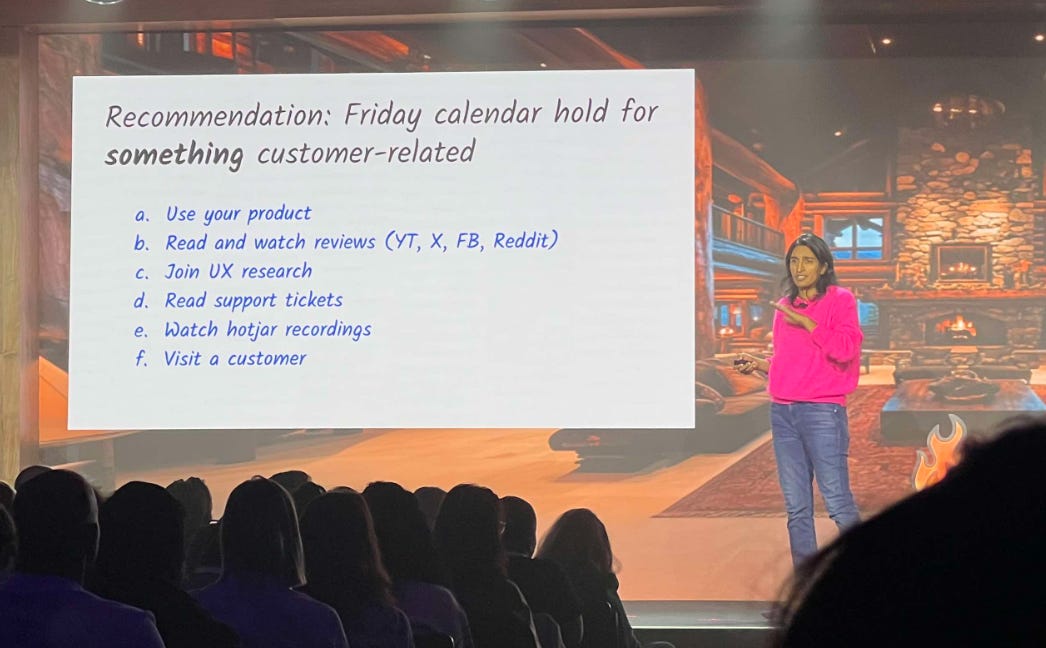7 Incredible Lessons from the Lenny & Friends Product Summit
My detailed notes and takeaways from the 7 amazing sessions that I attended
Dear subscribers,
Today, I want to share my detailed takeaways after attending the Lenny & Friends product summit.
The summit was packed with insights and wildly exceeded my expectations.
It was amazing to see 1,000+ product leaders gathered in one place and to meet some of you. Lenny himself is an inspiration to me — he is very humble and has always taken the time to give me advice despite becoming a PM cult leader 🙂.
For the rest of this post, I’ll share my detailed notes from the 7 sessions I attended:
AI killed traditional product management. Now what? | Claire Vo, LaunchDarkly
Simplify to win | Ami Vora, Faire
How to do product reviews right by doing it wrong | Yuhki and Mihika, Figma
Questions every PM should ask themselves | Shreyas Doshi
Essential insights for making products people love | Scott Belsky, Adobe
Crafting a compelling product vision | Ebi Atawodi, YouTube
Incorporating AI into your work | Kevin and Mike, OpenAI and Anthropic
Lenny will also be uploading the recordings to his YouTube channel in the coming weeks. Let’s dive into my notes below.
AI killed traditional product management. Now what? | Claire Vo, LaunchDarkly
Claire kicked things off with a bold assertion:
With AI, product work will take less time, less thought, and maybe fewer PMs.
She shared a great slide on tasks that you should be using AI to automate, including:
Drafting documents and updates
Creating meeting agendas and notes
Doing interview prep and consolidating candidate feedback
Writing user stories and product copy
Coming up with goals and OKRs
Claire closed with this 3-step plan to become an AI-first product manager:
Use AI to automate the boring parts of the PM job to make time for creativity.
Acquire new skills like AI prompt engineering and rapid prototyping.
Multiply your impact by teaching teams how to harness AI internally.
Here are some great quotes from Claire:
I used to draft a product strategy myself. Now, I’m hanging out in my minivan talking to ChatGPT so that it’ll draft the strategy for me.
Don't look at Al as how you can get it to do 100%; look at it as how it can get you to 75% faster than starting from 0 can.
Product work takes less time, so you can spend more time with users, less thought so you can be more creative, and fewer PMs. AI will collapse the talent stack, but it doesn’t have to break your team. There are no lanes.
Simplify to win | Ami Vora, Faire
Ami is one of my favorite product leaders, and her core lesson is to:
Have a maniacal focus on simplicity because it’s the ultimate competitive advantage.
Ami led WhatsApp to 2B users and 100B messages daily by focusing the team on a single north star: "Did my messages and calls go through, for free, every single time?" Every decision led to nailing this core use case to make the product indispensable to users worldwide.
To simplify, Ami suggests answering 3 questions:
What should I build? Focus on what makes your product indispensable. Being flashy and fun are just nice-to-haves.
How should I build? Make your product intuitive and use patterns that users are already familiar with.
How to tell a story? Understand what stories users are already telling. Think exposition, rising action, climax, and denouement.
Finally, I love this quote from Ami:
Be patient. PMs always have a countdown clock on what the ROI is. Instead, spend time with customers. Hold a Friday slot to do something customer-related (e.g., use the product, visit customers). Find a customer who says your product changed their life.
How to do product reviews right by doing it wrong | Yuhki and Mihika, Figma
Yuhki and Mihika flipped the script on how we think about product reviews. Their controversial point of view is that:
Product reviews aren’t for making decisions — they’re for winning trust.
If you think about it, most decisions are made daily with your team and users, so reviews are about building executive confidence to let you run with it. Yuhki and Mihika shared some great advice on how to make reviews work for you:
Build up context first → ruin the punch line. Execs are impatient and easily distracted, so start with your actual recommendation.
Cover all your bases → make a meme. “Flides” instead of Figma Slides became a meme, and 3.5M making slides in Figma was a focal point.
Circle back if you’re unsure → share your gut. Leaders don’t like “we’ll circle back later,” so don’t be afraid to share your gut.
Make a bold pitch → But also be your biggest skeptic. Talk to users and show the option space. Pre-empt the spicy questions by bringing them up yourself.
Watch my Mihika interview and get the slides from this session for more.
Questions every PM should ask themselves | Shreyas Doshi
Shreyas shared four questions that he wishes he asked himself earlier in his career:







